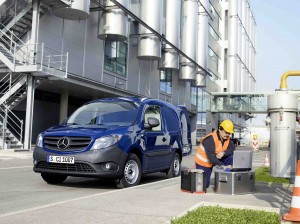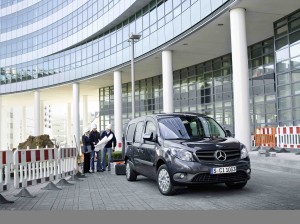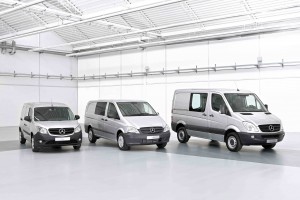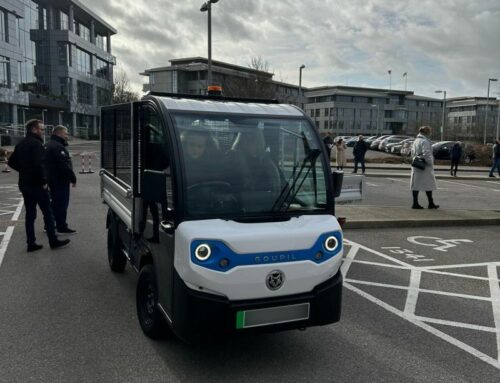
Mercedes' head of design, Bertrand Janssen, says the company focused on making the Citan, which is based on the Renault Kangoo, a 'real Mercedes'
Story: John Griffiths, industry correspondent
The question was lobbed as a joke; the reply volleyed back as a shock.
Would Mercedes-Benz make a high-performance, AMG version of the vehicle it was proudly unveiling on the now-defunct trading floor of Amsterdam’s glorious old former Stock Exchange?
The resulting collective giggle among the world’s assembled media hacks was understandable. The unveiling was of the Citan, the family of small Renault-based and Renault-built vehicles with which Mercedes intends to re-enter Europe’s burgeoning light van sector later this year after a seven-year gap since the Vaneo.
Hey, why not? came the response from Volker Mornhinweg – as its global head the biggest of all big cheeses at Mercedes-Benz Vans.
Cue frowns, puzzlement and “can he be serious?” head-shakes among hacks.
Okay, Mornhinweg himself was half-joking, grins Bertrand Janssen. But he was making a serious point. The Citan will go, and adapt to, wherever the market’s tides and currents take it. Nothing, no matter how seemingly unlikely, should be ruled out.
Janssen should know. He is responsible for design at Mercedes-Benz commercial vehicles and it was him and his team who have steered the Citan into being from the moment the first talks began within this unlikely alliance between premium and volume, value-for-money manufacturers.
“It’s effectively a new market for us but we’re going into it with the objective of expanding it and taking it in whatever direction we eventually want to go. Morninhweg said in future there could be maybe be an AMG. Okay, that’s very extreme now. But he was sending the message that the spin-offs (from the basic Citan vans) could be very positive. Or there could be a 4 x 4; anything is possible from that point of view,” says Janssen.

The new Citan panel van will be available in three body lengths, including this compact 3.94m version
“Our main objective, however, has been very clear: to develop a product wholly for the commercial market. But whatever any spin-off might be, like a people-mover – that spin-off we will regard as a positive and we will take it into account. To have a certain amount of percentage for a people mover was in the package, anyway, and is quite fine by us if it goes also in a direction like Citroen’s Multispace Berlingo. And if demand turns out to run higher than we expected, under our agreement with Renault we have spare production capacity built in.”
Janssen accepts that there may be many potential customers, particularly among SMEs, who may query whether Mercedes is not in danger of devaluing its premium brand image by such a tie-up with a French volume manufacturer and the simple ‘badge engineering’ that the alliance might imply.
They would be wide of the mark, however, he insists. “Today it is true that if you walk around the Amsterdam show you will see a lot of examples – I won’t mention names – where they only do badge design. And we said right at the beginning that if you do that you only cheat the customer.
“In the first meetings we set out what we regarded as the minimum parts changes needed to make it a Mercedes range. That was very important…we not only wanted to show visually that it is a Mercedes but also that when the customer actually comes to experience driving it, that it truly is a Mercedes. That’s why we have made so many changes; to the springs, the suspension, to the roadholding, to the cushions of the seats, enhancement of the engines – so that as soon as you step in the vehicle and you drive away you say ‘yes’, to yourself, ‘this is a typical Mercedes’.”
After a period of negotiation it was agreed that Renault own versions – the next-generation Kangoo business van – will have all the body length, wheelbase and weight variants being offered by the Mercedes-Benz range. “The body-in-white itself, the basic structure, that’s Renault. But we said we would make a complete new nose on it, a complete new back on it, and we’d make a complete new interior by way of a dashboard to get the differentiation; a differentiation not only in terms of the perception of the Citan being a Mercedes but ergonomics as well. Everything we did we trialled and improved from a quality perception.”
Changing the body so comprehensively, Janssen acknowledges, was a considerable challenge. “You have to respect the hard points of the basic Renault vehicle. And sometimes if you want to make a design change as a stylist, you find that a hard point is in the way. So you have to challenge the hard point, to overcome it while respecting it as you try to create what you are seeking to achieve. So from that point of view it’s much harder than starting from a sketch (as would be done if the project was Mercedes’ alone). However, we were able to do a lot of changes because, really, in a way we are Renault’s customer and Renault would say, yes ok, we will try and find out a way to manage it like that.
“A good thing about the designers is that we had a very clear meeting in Paris. We made a strategy together, including for the first facelift. So they looked over our shoulders and we looked over theirs – very unusual because each was looking at what is happening with the future of Mercedes and Renault – and we clearly said you may not, for example, copy this grille for your coming facelift. And we put this in a document and they signed it; and the document also said that certain elements would remain unique to Mercedes and to Renault.
“But it’s absolutely brilliant because it’s working with different cultures. We are very strong as a premium brand and Renault is very good at light, cost-effective vehicles. So we also learn from them. We have also some good technical solutions. But then they also can come up with a solution, which is good quality but less expensive. So we say ‘sure, if it’s less expensive, why not?’ So it’s really a learning situation for both of us.”
Clearly SME small fleet van operators will now have an impressive new choice in the market – with a three-pointed star on the grille.
- Don’t forget to read The new Mercedes-Benz Citan – and why it’s destined to be a big hit








Leave A Comment